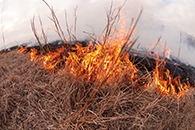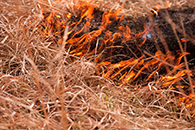Study finds benefits to burning Flint Hills prairie in fall and winter
Thursday, July 31, 2014
MANHATTAN — Kansas State University researchers have completed a 20-year study that looks at the consequences of burning Flint Hills prairie at different times of the year. It finds that burning outside of the current late spring time frame has no measurable negative consequences for the prairie and, in fact, may have multiple benefits.
The study was conducted by Gene Towne, research associate and the Konza Prairie Biological Station fire chief, and Joseph Craine, research assistant professor, both in the Division of Biology. They recently published the study, "Ecological consequences of shifting the timing of burning tallgrass prairie," in the peer-reviewed scientific journal PLOS ONE. The study is the most comprehensive on seasonal burning ever conducted.
The Flint Hills are 82,000 square miles of unplowed tallgrass prairie that stretch from eastern Kansas to north-central Oklahoma. The region is an important area for grazing cattle. In a typical year, ranchers annually burn thousands of acres of grassland to reduce the abundance of undesirable trees and shrubs while promoting nutritionally rich grass for that summer's grazing.
Currently, burning of Flint Hills prairie is typically concentrated in late April. The time frame stems from research conducted more than 40 years ago.
"Burning in the Flint Hills has been a scientific and political issue for at least 80 years," Craine said. "Burning the prairie is ecologically important to Kansas grasslands and to ranchers in the region. But when everybody burns at the same time, it becomes a source of contention for cities downwind of the smoke and creates legal issues when clean air standards are exceeded."
The PLOS ONE study uses 20 years' worth of burning data collected at the university's Konza Prairie Biological Station. In 1994 large, replicated watersheds of the native prairie were set aside. Over a 20-year period, each section was burned annually either in the fall, winter or spring. This enabled researchers to look at what effect burning during a particular season had on the vegetation long-term.
They found that when the prairie is burned in fall or winter, grass composition and production was not negatively affected compared to burning in the spring.
"This research indicates that ranchers do not have to restrict their pasture burning to only late April," Towne said. "Burning earlier in the season offers increased flexibility in ensuring that the pasture gets burned without reducing grass production."
Several benefits also were found for burning in the fall or winter.
Grasses in areas burned in the winter or fall had more time to respond to precipitation, which reduced their susceptibility to mid-season drought. Burning in the fall and winter also resulted in a more diverse prairie with more cool-season grasses. These grasses are available earlier and are of a higher forage quality for cattle.
By burning when many animals are active, fires in the late spring can devastate wildlife. Snakes, turtles, prairie chickens and other nesting birds are less likely to be destroyed during fall and winter burns, as wildlife is often hibernating underground or have not yet built nests, Craine said.
Additionally, moving to a more flexible burning schedule helps manage the large volume of smoke that carry to Manhattan and Wichita, Kansas; Kansas City, Missouri; Lincoln, Nebraska, and other cities downwind. Burning over a wider time window would reduce the intensity of the smoke that carries to cities downwind and would be produced at times that are less likely to produce ground-level ozone.
"By burning earlier in the spring than what has been traditionally recommended, many of the smoke management issues in downwind cities can be alleviated," Towne said.
Researchers say that while there is always more research that needs to be conducted, there is no evidence that burning grasslands in the Flint Hills during fall and winter would have a negative effect on the prairies compared to late-spring burning.
"It looks like one of those rare situations where everybody wins," Craine said. "Our ranchers win. Our prairies win. And our neighbors downwind of the Flint Hills also win."


